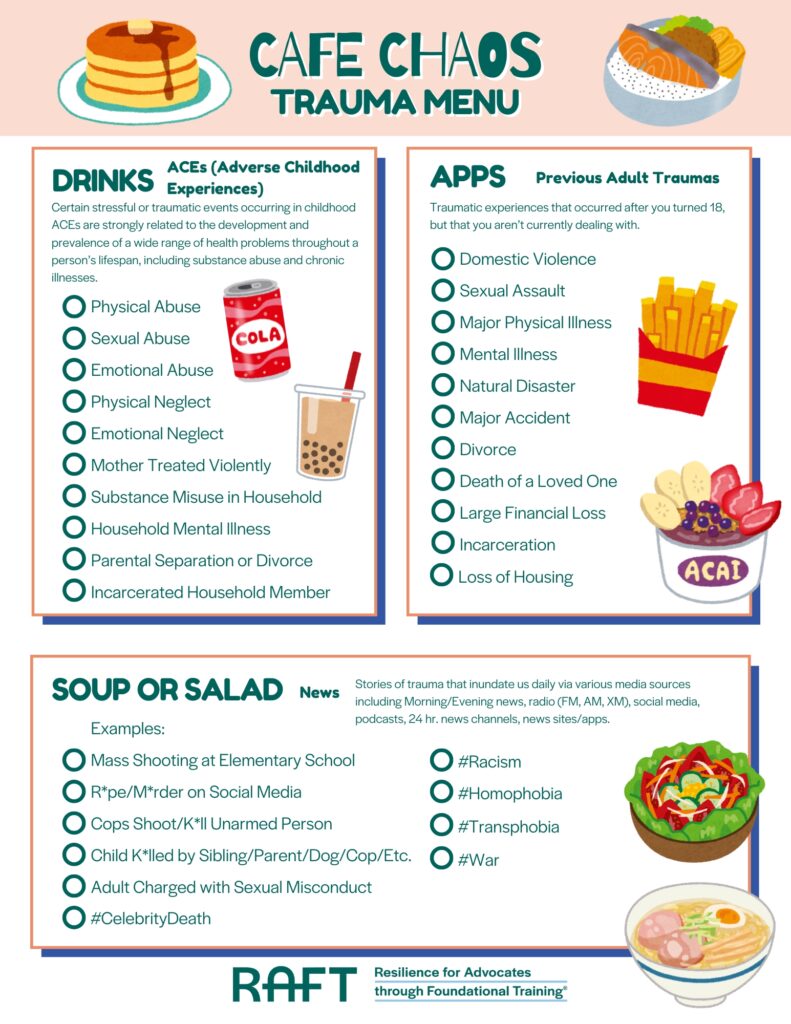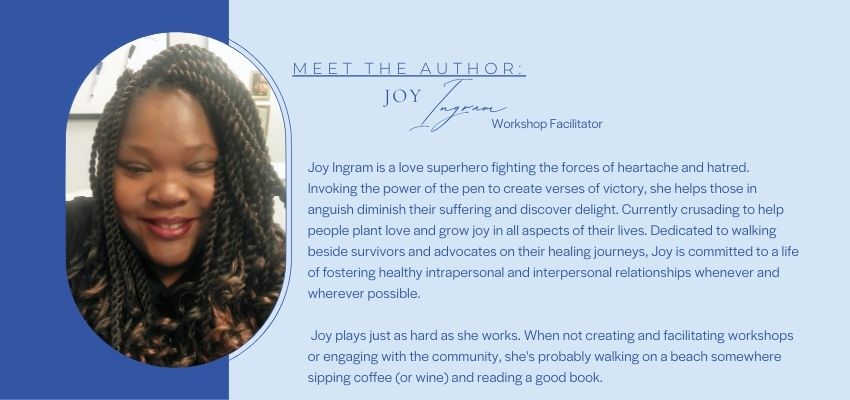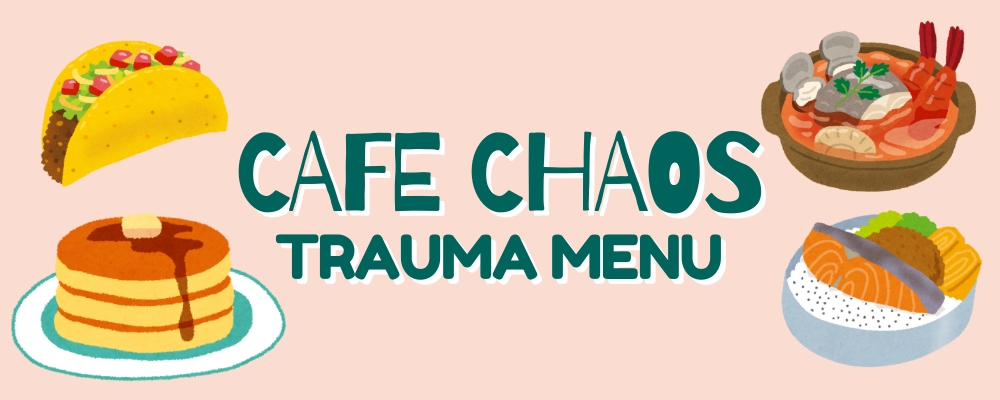Cafe Chaos: Where Trauma is the Special of the Day Every Day
Joy Ingram, May 13, 2025
*CONTENT WARNING: this blog discusses multiple forms of trauma including childhood, adult, and vicarious trauma, gun violence, and domestic violence.
As advocates we are programmed to help others. We walk full speed ahead into other people’s crises without a second thought as to how it affects us. We graciously take on the vicarious trauma that comes with being empathetic. We experience compassion fatigue and exhaustion due to the stress and strains of other people’s problems and the flawed systems in which we work. This can lead to exhaustion, overwhelm, and in some cases, burnout.
However, there are other factors that can contribute to these, and other types of mental anguish and we don’t even realize it. What are these factors? Often it is our own unrecognized trauma. Unrecognized trauma refers to previous traumatic experiences that people haven’t acknowledged and therefore haven’t processed. This often leads to various negative impacts on their mental, emotional, and physical well-being. This can happen when trauma is denied, repressed, or simply not viewed as a traumatic experience.
Not recognizing or treating your trauma doesn’t erase, undo, or heal it. Just like not treating a physical injury or disease (heart disease, diabetes, a broken bone) doesn’t mean you don’t have it, nor does it help you control or cure it.
What unrecognized (and therefore untreated) trauma does do is manifest as issues such as low self-esteem, intense and long-term anger, physical pain, depression, PTSD, and other problems. These issues can lead to maladaptive coping skills like eating disorders, substance use, and other high risk and unhealthy behaviors.
Different Forms of Unrecognized Trauma
Unrecognized trauma exists in many forms such as:
- Repressed memories
- Events so traumatic that you put them out of your mind as a way of coping. These may show up later as flashbacks, nightmares, or violent and alarming responses to triggers.
- Minimized or dismissed traumatic events
- Events that caused distress, but not in a way that’s often depicted in media, therefore not seen as truly traumatic (ex: you have a near death experience, but because you didn’t sustain major physical injuries, you minimize it and try to convince yourself that it wasn’t that bad).
- Hurtful things that you were told to not dwell on, but just get over
- Various losses and the grief that goes with loss (career, relationship, life, etc.)
- Childhood experiences that you feel shouldn’t affect you anymore because they happened so long ago
- In addition to the things on the ACEs list there are other things children experience that are traumatic and should be addressed accordingly. This includes diagnosis with a disabling or chronic illness, death of a parent or sibling, witnessing major violence in the community, living through a natural disaster.

Introducing the Trauma Menu
After attending a three-day conference on trauma in 2017, I realized that not only was I being negatively affected by the content of the conference and working directly with trauma survivors, but I was also suffering from many unrecognized and untreated traumatic events. Knowing that I could not be the only one dealing with this issue, I created this trauma “menu” as part of a workshop on self-care for advocates. I wanted an analogy that everyone could relate to, so I used food and a menu because we’ve all ordered food at a restaurant, and we all eat. Just like we take in food, we take in trauma. Similarly, food waste must be removed for us to be physically healthy in the same way that trauma and its negative byproducts must be removed in order for us to be mentally healthy.
After taking the time to deeply reflect on my life, I realized that I had more unrecognized trauma than I’d previously thought. Placing my own order from the trauma menu allowed me to acknowledge some formerly unidentified sources of mental anguish in my life. Taking inventory of the different damaging events helped me begin a long and arduous healing process that included using some of the tools I’d previously acquired in therapy, as well as getting back in therapy to gain new skills and tools.
For example, one of my many unrecognized traumas was (wait for it...) domestic violence. In 2017 as a new victim advocate, I didn’t even realize that I, too, had been a victim. This was mainly because when I was going through it, I didn’t understand what domestic violence was. I thought it was only physical: the woman with the black eye and the busted lip. That wasn’t me. He never hit me. I never had to go to the hospital to be treated for injuries. I didn’t have any bruises that I needed to hide. The abuse wasn’t physical; it was psychological and emotional. Because I didn’t have any physical injuries, I minimized the situation. I didn’t see it as trauma, violence, or abuse. Even after he held a gun to my head and threatened to kill me, I didn’t see myself as a victim or as traumatized. I had lived through the situation with no lacerations or broken bones. S.W.A.T. didn’t have to rescue me. I went to work the next day. It was no big deal.
But it was. The day after he convinced me that I was going to die I fled to a family member’s home. (Yes, I did go to work that morning, but that was to keep up the routine so he wouldn’t think I was leaving.) For years after I escaped that relationship in 2008, I had nightmares about the situation, about running for my life, about being unsafe and attacked in my home. I couldn’t deal with anything related to guns. If there was a gun reference in a song, tv show, or movie and I knew it was there I’d change the channel. If it came up unexpectedly, I’d leave the room and often go somewhere and cry in private. Reading about or seeing similar situations in the news nauseated me. I had to move out of my apartment because everything about it reminded me of that day.
Later, I thought I’d moved past that situation and all the trauma it brought. Truthfully, that trauma was simply pushed down and replaced by other traumas and their negative effects. It took me years to recognize, accept, and begin to unpack them all. Still, coming to terms and finally dealing with these issues, though extremely difficult, is one of the healthiest things I’ve ever done.
As a survivor, I encourage you to take the time to review the menu and “place your order”. What traumas did you experience as a child? What traumas did you experience previously as an adult? What stressors are you dealing with now as an individual? What are you taking in via the media and news? What are you experiencing as a result of your advocacy work?
As an advocate, I implore you to invite others in your trusted network (friends, family, mental health professionals) to dine at this table with you. Sometimes you need someone to suggest that you’ve had enough to eat or drink for the evening and that you need a to go box to save some for later. Other times, it’s just nice to not eat alone.
Which Traumas are on Your Plate?
Here’s how to use the Trauma Menu:
- Download the trauma menu digital asset here.
- Make sure you are in a positive place/mood before placing your order. This exercise may be difficult, so you don’t want to do it when you’re already having a bad day.
- Read through the menu and use the order form to add items from each of the categories.
- Look over your menu and reflect on your different traumas and where they may have been/may still be impacting you (journaling can be a great tool here).
- If you have a therapist, consider discussing this menu with them. If you don't have a therapist, consider if it might be beneficial to reach out.
- Review your trusted network (more on trusted networks can be found in Building Resilience to Shame workbook) and find someone you can talk to about some of the items on your menu.
- Over time revisit your menu and take some time to reflect on your own. Try picking one menu item at a time to reflect on to prevent overwhelm








